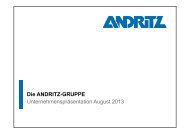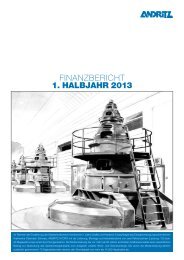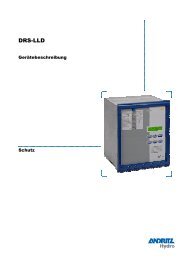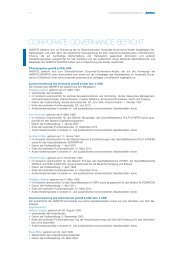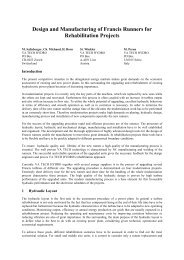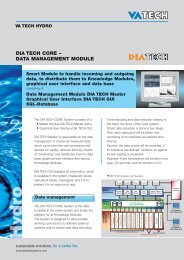2004 - ANDRITZ Vertical volute pumps
2004 - ANDRITZ Vertical volute pumps
2004 - ANDRITZ Vertical volute pumps
Create successful ePaper yourself
Turn your PDF publications into a flip-book with our unique Google optimized e-Paper software.
78<br />
GLOBAL SERVICES/ACTIVITIES<br />
BUSINESS PROCESS MANAGEMENT<br />
BUSINESS<br />
PROCESS<br />
MANAGEMENT<br />
The strong growth of the Andritz Group over the<br />
years has added a wide variety of organizational<br />
procedures and IT systems. This creates a challenge<br />
for inter-company integration of Business<br />
Areas, which is an increasingly important goal. In<br />
2002, Andritz established a centralized function to<br />
focus on these issues and to standardize essential<br />
business processes where needed. This includes<br />
the implementation of the business processes<br />
within a common IT structure.<br />
Need for a Group Enterprise Resource<br />
Planning (ERP) system<br />
A detailed study within Andritz identified several<br />
different and local ERP systems in use. Most of<br />
those systems had been used for a number of<br />
years and do not fulfill the long-term requirements<br />
of the Andritz Group. Given the global activities of<br />
the Business Areas, the Andritz Group made the<br />
decision to change to a global ERP system.<br />
ASAP – Andritz towards global SAP<br />
Following the decision to establish one global<br />
ERP system and after choosing the vendor (SAP),<br />
a project was established under the name of ASAP<br />
(Andritz towards global SAP). The project was<br />
officially started at the end of the First Quarter of<br />
<strong>2004</strong>.<br />
Since then, about 50 team members have been<br />
working on the definition and harmonization of the<br />
ASAP Business Processes. The task has been to<br />
determine how the essential business processes<br />
– from sales and project execution to procurement,<br />
manufacturing, service, and finance – will be<br />
supported by SAP in the future.<br />
Goals of the new ERP system<br />
The main goal of the new Andritz Global ERP<br />
system is to support the business activities as<br />
efficiently as existing systems do today, with the<br />
added advantage of being able to function globally<br />
for all Andritz organizations. This global system<br />
<strong>ANDRITZ</strong> <strong>2004</strong><br />
will facilitate Group integration, common global<br />
business, integration of new acquisitions, and<br />
organizational flexibility.<br />
The global ERP system will enable global<br />
resource sharing, reduction of inventories, pooling<br />
of functions (i.e. accounting, purchasing, etc.),<br />
automation of inter-company business, and<br />
improved financial overview and reporting. Risks<br />
– and therefore costs – for IT system operation are<br />
expected to decrease since there will be just one<br />
global system to be maintained and updated.<br />
It is anticipated that the global ERP system will<br />
result in improved customer service, which will give<br />
Andritz a competitive advantage.<br />
Major project steps<br />
After defining the relevant business processes,<br />
the ASAP team began implementing them within<br />
the SAP system in June <strong>2004</strong>. Approximately<br />
80% of the processes were finalized in <strong>2004</strong>.<br />
At the end of <strong>2004</strong>, the new ERP system had its<br />
first test – integrating all the related business transactions<br />
of an existing customer project, including<br />
service orders. The test was successful.<br />
So as not to disrupt daily business more than<br />
absolutely necessary, the ERP system will be<br />
established step-wise over a period of six years.<br />
Each location is being staged for implementation<br />
based upon when their existing systems would be<br />
in need of replacement.<br />
Beginning March 2005, the ASAP team will<br />
focus on Finland where outdated systems will be<br />
replaced and SAP will be implemented for about<br />
420 users. This is the first rollout of the system. It<br />
is planned to begin implementation in China at the<br />
end of 2005 and move to North America, where<br />
most of the old systems will be replaced in the<br />
course of 2006.






